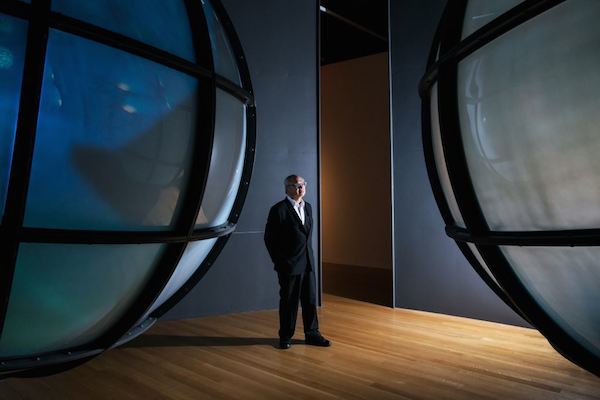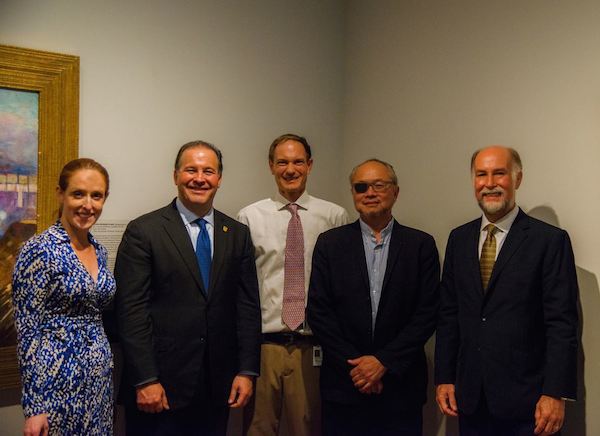
The grand opening of “Connecting the World: The Panama Canal at 100” at the Mint Museum
By Leigh Dyer, Mint Museum UPDATE: The Charlotte Observer reviewed the exhibit on Dec 13. Click here to read the piece.
What a difference a month can make! Looking back to our first Knight Arts blog entry at the one-month point before our grand opening of the exhibition Connecting the World: The Panama Canal at 100, it seemed nearly impossible that all would be ready in time to invite the public to see Mel Chin’s visionary creation, SEA to SEE, by our target date of October 30. In fact, even two days before the opening, I had my doubts.
Mel Chin. American, 1951-. SEA to SEE 2014, Mixed media installation. Part of “Connecting the World: The Panama Canal at 100,” Mint Museum Uptown. Mint Museum photo.
On October 28, we invited representatives from a local magazine distributed to all 80,000 elementary school families in Charlotte-Mecklenburg Schools, My School Rocks, to interview Chin in our gallery as assembly was taking place. The interviewers were two fourth-grade students from Shamrock Gardens Elementary School, which had participated in Chin’s “Fundred Dollar Bill” project to draw attention to prevention of childhood lead poisoning. The students had done their homework and drawn up a list of questions to ask the artist about his inspiration and his work.
But what greeted us was a gallery so full of the glass panels that were to become the hemispheres of SEA to SEE that we almost couldn’t let the students walk inside to see where the installation was taking shape. The panels had been unpacked but none had yet been installed, so they were scattered across the gallery floor. Undaunted, the students set up their interview on a bench beside another prominent occupant of the Brand Galleries of Mint Museum Uptown: An original 3-ton steam shovel bucket that had been used to dig the Panama Canal, transported from Colorado’s Nederland Mining Museum.
It was a rare opportunity for outsiders to see the exhibition taking shape while access to galleries is normally tightly restricted. As the installation team continued working busily behind them, one student asked Chin what inspired him to create his installation. His response: “When we talk about the awesome history of the Panama Canal, which is considerable, I started to look at it in a very contrary way. I said maybe 100 years of focus on this incredible human event … were enough. It would be covered by the rest of the exhibition. Maybe we needed to further think of what flanks the Panama Canal, our oceans, which are in dire situations right now.”
Incredibly, just one day later, the hemispheres were almost entirely complete in time for a historic event. The United States Ambassador to Panama, Jonathan D. Farrar, was visiting as an honored guest of the Mint as well as the U.S. Department of Commerce’s “Discover Global Markets: The Americas” conference, which had moved from Raleigh to Charlotte in order to partner with the exhibition. But unexpectedly, the Mint’s CEO, Dr. Kathleen V. Jameson, had been able to issue an impromptu invitation to Farrar’s counterpart, H. E. Emanuel Gonzalez-Revilla, Ambassador of Panama to the United States, to join the exhibition tour. Gonzalez-Revilla spoke at a World Affairs Council of Charlotte luncheon that day but had originally been unable to stay long enough to attend the exhibition’s grand opening. It was simply good luck that both were able to tour the gallery at the same time, and both were gracious enough to pose for a photo in the gallery along with Chin, Jameson, and exhibition curator Dr. Jonathan Stuhlman.
The next day brought the exhibition media preview, attended by more than a dozen local print, television, and online outlets as well as bloggers and freelance writers. Farrar attended and spoke to several reporters before Stuhlman led attendees on a gallery tour. That evening, all the hard work finally paid off as more than 400 people – a combination of Mint guests and participants in the “Discover Global Markets” conference – flocked to the museum for the exhibition preview celebration. And just days later, amid a flood of media coverage (which included international clips from the Spanish-language EFE News Service published in Panama’s major daily newspapers), came the first critical review of both the exhibition and the Knight grant-funded SEA to SEE project. Said Barbara Schreiber in The Charlotte Observer: “The exhibition’s single most compelling aspect is Chin’s ‘SEA to SEE.’ Created in collaboration with data scientists, designers and other creative minds, this conceptually and technically complex installation plunges the viewer between two large, globe-like projection screens, one with digital animations of the Pacific, the other of the Atlantic. ‘SEA to SEE’ is not about the canal as an engineering marvel; it is about the canal as a destructive force. It is mysterious and unnerving, as the viewer is surrounded by environments that the canal, a gash in the land, has disturbed.” Finally, Chin’s vision had come to life, and hers would be the first of many positive reactions in the coming days.

From left: Dr. Kathleen V. Jameson, President & CEO, The Mint Museum; H. E. Emanuel Gonzalez-Revilla, Ambassador of Panama to the United States; Dr. Jonathan Stuhlman, Senior Curator of American, Modern, and Contemporary Art; Artist Mel Chin; and Jonathan D. Farrar, Ambassador of the United States to the Republic of Panama. Mint Museum photo.
Recent Content
-
Artsarticle ·
-
Artsarticle ·
-
Artsarticle ·

